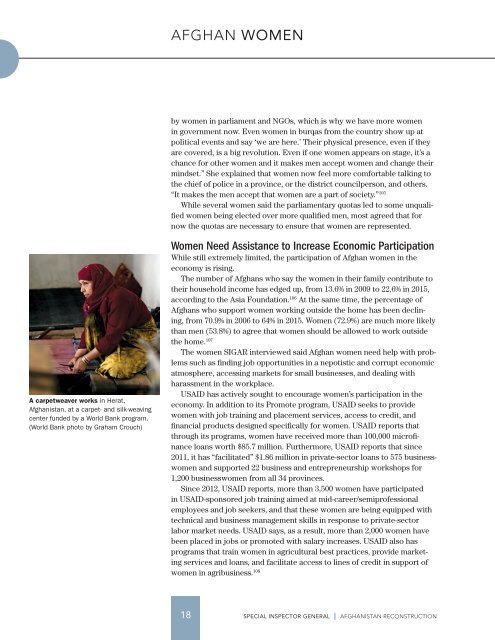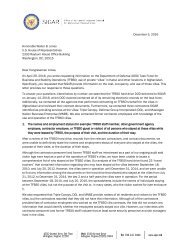SIGAR
2016-10-30qr
2016-10-30qr
You also want an ePaper? Increase the reach of your titles
YUMPU automatically turns print PDFs into web optimized ePapers that Google loves.
AFGHAN WOMEN<br />
by women in parliament and NGOs, which is why we have more women<br />
in government now. Even women in burqas from the country show up at<br />
political events and say ‘we are here.’ Their physical presence, even if they<br />
are covered, is a big revolution. Even if one women appears on stage, it’s a<br />
chance for other women and it makes men accept women and change their<br />
mindset.” She explained that women now feel more comfortable talking to<br />
the chief of police in a province, or the district councilperson, and others.<br />
“It makes the men accept that women are a part of society.” 105<br />
While several women said the parliamentary quotas led to some unqualified<br />
women being elected over more qualified men, most agreed that for<br />
now the quotas are necessary to ensure that women are represented.<br />
A carpetweaver works in Herat,<br />
Afghanistan, at a carpet- and silk-weaving<br />
center funded by a World Bank program.<br />
(World Bank photo by Graham Crouch)<br />
Women Need Assistance to Increase Economic Participation<br />
While still extremely limited, the participation of Afghan women in the<br />
economy is rising.<br />
The number of Afghans who say the women in their family contribute to<br />
their household income has edged up, from 13.6% in 2009 to 22.6% in 2015,<br />
according to the Asia Foundation. 106 At the same time, the percentage of<br />
Afghans who support women working outside the home has been declining,<br />
from 70.9% in 2006 to 64% in 2015. Women (72.9%) are much more likely<br />
than men (53.8%) to agree that women should be allowed to work outside<br />
the home. 107<br />
The women <strong>SIGAR</strong> interviewed said Afghan women need help with problems<br />
such as finding job opportunities in a nepotistic and corrupt economic<br />
atmosphere, accessing markets for small businesses, and dealing with<br />
harassment in the workplace.<br />
USAID has actively sought to encourage women’s participation in the<br />
economy. In addition to its Promote program, USAID seeks to provide<br />
women with job training and placement services, access to credit, and<br />
financial products designed specifically for women. USAID reports that<br />
through its programs, women have received more than 100,000 microfinance<br />
loans worth $85.7 million. Furthermore, USAID reports that since<br />
2011, it has “facilitated” $1.86 million in private-sector loans to 575 businesswomen<br />
and supported 22 business and entrepreneurship workshops for<br />
1,200 businesswomen from all 34 provinces.<br />
Since 2012, USAID reports, more than 3,500 women have participated<br />
in USAID-sponsored job training aimed at mid-career/semiprofessional<br />
employees and job seekers, and that these women are being equipped with<br />
technical and business management skills in response to private-sector<br />
labor market needs. USAID says, as a result, more than 2,000 women have<br />
been placed in jobs or promoted with salary increases. USAID also has<br />
programs that train women in agricultural best practices, provide marketing<br />
services and loans, and facilitate access to lines of credit in support of<br />
women in agribusiness. 108<br />
18<br />
SPECIAL INSPECTOR GENERAL I AFGHANISTAN RECONSTRUCTION




